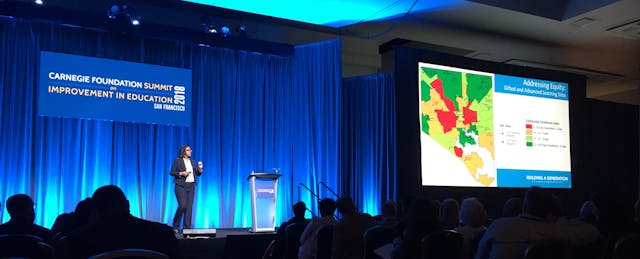Sonja Brookins Santelises, the CEO of Baltimore City Public Schools, sent a message to the teachers, principals, system leaders and non-profit professionals in the audience at her keynote on Wednesday: improvement science must be used in the context of a community’s individuals. It’s not about “fairy dust” or “easy answers.”
But first, a primer on “improvement science,” a phrase oft repeated at the 2018 Carnegie Foundation Summit on Improvement in Education, going on this week in San Francisco. The Carnegie Foundation describes it as a “user-centered and problem-centered approached to improving teaching and learning,” one that relies heavily on data to develop, revise and fine-tune processes. Arguably, the man most known for his work with improvement science is W. Edwards Deming, a statistician whose advice helped Japan rebuild its industries after World War II. Nowadays, you can see his ideas in action in a number of fields, including healthcare and education.
Santelises’ district, Baltimore City Public Schools, has faced a number of challenges, including low performance and heating issues. To turn those stories around, Santelises says that educators must take equity “out of the box of a philosophical, intellectual dialogue” and apply it to their everyday work.
Santelises showed the audience a 1937 Baltimore residential map that displayed redlining, or the sections of Baltimore that received loans and capital and which ones did not. There’s a bright red ring around the heart of the urban area—which received no loans—and then a wash of green further out.
Santelises said when she and her team started discussing the issue of redlining in Baltimore, it was “very convenient to throw rocks” at the housing authority. But as the educators mapped their own practices by creating a “community conditions index” that showed which areas in Baltimore received, say, more gifted and talented programs, they found to their dismay that the school system was reinforcing the old redlining practices. In response, Santelises and her team now look at their major initiatives and investments through that equity lense.
In addition to implementing equity in everyday work, Santelises also believes educators should tie improvement science with engaging young people and their communities.
“If we, as educators, and those who support educators, are going to move to the next wave of improvement, we have got to do it grounded in the knowledge that we’re doing this work with communities, not to communities,” she said.
She told the audience about a student in the school district who made a short video documenting life in West Baltimore. She didn’t share specifics about his situation, but said if educators were to look at his “data point” (of academic performance) they’d place him in the “red zone.”
“You’d say, he’s in high school and he’s three to four years below grade level, and you’d put him in a box, and then we’d cycle through him,” Santelisis said. “But we wouldn’t know that side of Xavier.”
Eventually, district employees learned that while Xavier wanted to attend college, he was not college-ready. So, they began determining what Xavier is good at and how they could use that information to help him. A year and a half later, Xavier’s reading level had increased by two and a half years, and he has been accepted to the Maryland Institute College of Art.
“That is because the face of the data became also the question of who is Xavier,” she said. “And if this young person has the talent to do this, then what do we need to do differently?”


